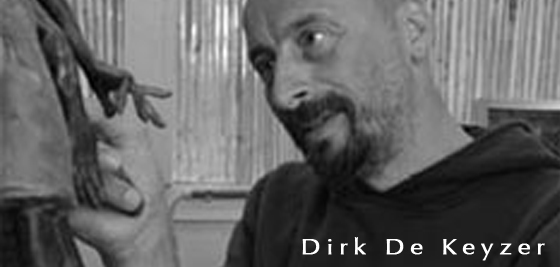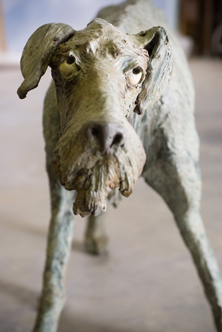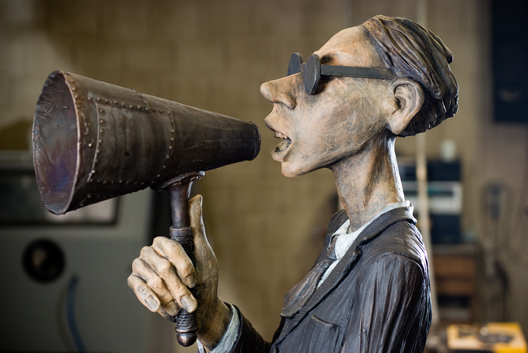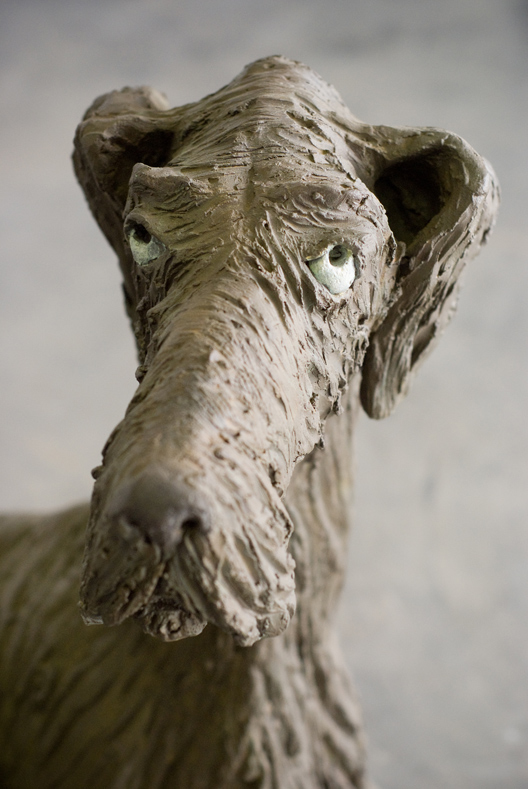

| Dirk De Keyzer | Mail voor nadere info / foto's |
| In een tijd en omgeving
waar creativiteit eerder een afwijking dan een verdienste was wist de
jonge Dirk De Keyzer niet welke richting hij uit wou met zijn leven.
Dus richting vakschool en op spoor gezet voor de fabriek. Maar minder
platgetreden paden lonkten, waardoor hij een paar jaar later in de
Koninklijke academie van Eeklo terecht kwam en daar de liefde voor het
werken in brons opdeed. Steeds meer werd brons voor Dirk het ideale
medium om beeld te geven aan zijn denkwereld. De grote voorbeelden George Minne, Constantin Meunier en August Rodin indachtig, werd in zijn atelier de ietwat in onmin geraakte traditionele verloren was methode waar nodig opnieuw uitgevonden en bijgeschaafd. Daarbij werden de grenzen van wat technisch haalbaar geacht was niet geschuwd en soms zelfs overschreden. In tegenstelling tot zijn voornaamste invloeden verlaat dirk het klassieke vormidioom om een volledig eigen vormentaal te ontwikkelen. Dit maakt het onmogelijk om zijn werk een plaats te geven binnen bestaande stromingen, bewegingen of modes. De belangrijkste inspiratiebron voor het beeldhouw werk van Dirk De Keyzer is niets minder dan het leven zelf. De wereld wordt omgebogen naar en alternatieve parallelle wereld waarin grote en alledaagse problemen gecompenseerd worden. Zonder in een kinderlijke naiviteit te vervallen krijgt positiviteit en grensoverschrijdend denken een zeer belangrijke rol toe geschreven. Dit blijkt vooral uit het feit dat de figuren in geen enkele, of juist in alle culturen schijnen thuis te horen. Bij uitbreiding zou men het een geheel eigen invulling aan het begrip "universele mens" kunnen noemen, verheven boven uiterlijke kenmerken, culturele verschillen en tijdelijke trends om zo de nadruk op het individu en diversiteit te leggen. Een ander belangrijk aspect binnen de kunst van Dirk de Keyzer is humor. Hij is er sterk van overtuigd dat humor, in tegenstelling tot negativiteit, de speerpunt van maatschappijkritiek kan zijn. Ontwapenende humor eerder dan billenkletserij om relativering en verdraagzaamheid te stimuleren. Het werk van Dirk De Keyzer roept in deze drukke tijden op tot stilstaan bij de ondraaglijke lichtheid van ons bestaan. Een moment van zelfreflectie om op te roepen tot een kleine ontsnapping uit dagdagelijkse realiteit. De sculpturen zijn een momentopname van Dirks alternatieve wereld en nodigen de geamuseerde toeschouwer uit om toe te treden tot de beeldhouwer zijn persoonlijke universum. Op die manier beleeft de toeschouwer tijdens het kijken dezelfde ervaring als de kunstenaar bij het creeren. Dirk ziet het creatieproces als een soort therapie die hem helpt de wereld vanuit een ander perspectief te aanschouwen en probeert dit te projecteren op de toeschouwer. Niettegenstaande zijn eigen unieke vormentaal krijgen universele gegevens zoals het menselijk streven naar geluk, schoonheid en harmonie een prominente rol toebedeeld. Op deze wijze tracht de kunstenaar in dialoog te treden met zijn publiek waarbij net als in het leven zelf niet altijd wordt gefocust op vooropgestelde doelen maar eerder op de weg daarheen. A une époque et dans un environnement ou la créativité était plutôt considerée comme une singularité et non comme un don, le jeune Dirk De Keyzer ne savait plus quel sens donner a sa vie. Apres avoir effectué sa scolarité a l'école professionnelle qui l'aurait mené à trouver un travail a l'usine, il choisit un parcours moins linéaire et poursuivit ses études à l'Academie Royale d'Eeklo ou il decouvrit la passion pour le bronze. Progressivement le bronze devient pour Dirk le materiau idéal pour laisser libre cours son monde imaginaire. C'est en se référant à Georges Minne, Constantin Meunier et Auguste Rodin, qui furent ses exemples, qu'il reinventa et améliora dans son atelier la méthode traditionnelle de la cire perdue, methode qui était quelque peu tombée en desuétude. Il se surpassa dans ses procedes techniques. Contrairement à ceux qui l'ont principalement influencé, Dirk sort des sentiers battus et développe son propre mode d'expression. Il est des lors impossible de classer son travail dans un quelconque mouvement ou genre. La principale source d'inspiration pour le travail de Dirk De Keyzer n'est autre que la vie même. Il crée un monde parallele qui offre une alternative aux problèmes quotidiens. Sans vouloir tomber dans une quelconque naiveté, il attribue une place preponderante a la pensée positive et constructive. C'est la raison pour laquelle ses sculptures ne semblent faire partie d'aucune culture et de toutes les cultures en meme temps. En extrapolant l'on pourrait dire qu'il lui importe surtout de représenter "l'homme universel" faisant fi des divergences culturelles ainsi que des modes ambiantes. Ainsi accentue-t-il et allie-t-il l'individu et la diversite. L'humour constitue également un aspect essentiel dans l'oeuvre de Dirk De Keyzer, un humour qui permet de jeter un oeil critique sur notre societé en relativisant les choses et en stimulant en meme temps l'esprit de tolérance. L'oeuvre de Dirk nous invite, dans une période trépidante qui est la notre; à s'attarder a l'insupportable légéreté de notre existence. Un moment d'autoreflexion qui nous permet d'échapper quelque peu la réalite quotidienne. Etant le reflet de son monde anticonformiste, les sculptures de Dirk incitent le spectateur amuse à adhérer à ce monde. De cette facon, le créateur et le spectateur se rejoignent complètement. Dirk considère l'acte de créer comme une espèce de thérapie qui l'aide à voir ce qui l'entoure d'un autre oeil; ce qu'il essaie à son tour de projeter sur le spectateur. Indépendamment de son mode d'expression personnel, les thèmes universels tels que la quête du bonheur, la beauté ainsi que l'harmonie jouent un role préponderant dans son oeuvre. L'artiste essaie ainsi de dialoguer avec son public et de ne pas focaliser sur les objectifs préetablis mais de privilegier le chemin et la maniere qui y mènent. In a time and environment where creativity was considered disturbing, rather than being a merit, the Young Dirk De Keyzer found it hard to decide in which direction to head with his life. Like so many boys of his age, he was sent out to learn a craft, destined to go to work in a factory. Other horizons would call though, and that's how he ended up in the Royal academy of Eeklo. It was there that he discovered his predilection for bronze. It became more and more obvious that bronze would be the only medium for Dirk to give expression to his inner most thoughts and artwork. Fascinated by great sculptors like George Minne, Constantin Meunier and Auguste Rodin, he reinvented and explored the possibilities of the by then almost lost art of the "lost wax" method. In contrast to his influences, Dirk leaves the classical form-idiom and manages to develop his very own language in In a time and environment where creativity was considered disturbing, rather than being a merit, the Young Dirk De Keyzer found it hard to decide in which direction to head with his life. Like so many boys of his age, he was sent out to learn a craft, destined to go to work in a factory. Other horizons would call though, and that's how he ended up in the Royal academy of Eeklo. It was there that he discovered his predilection for bronze. It became more and more obvious that bronze would be the only medium for Dirk to give expression to his inner most thoughts and artwork. Fascinated by great sculptors like George Minne, Constantin Meunier and Auguste Rodin, he reinvented and explored the possibilities of the by then almost lost art of the "lost wax" method. In contrast to his influences, Dirk leaves the classical form-idiom and manages to develop his very own language in sculpting. This is the reason why it's impossible to place his art under certain trends or movements. The most important source of inspiration for Dirk De Keyzer is no less than life itself. He molds the world into an alternative, parallel universe in which all problems, be they big or small, are compensated for. In doing so, he cunningly avoids the traps of becoming childish or naive, while border-crossing, positivism and out of the box thinking are the key-words. This particularly shows in the fact that his figures could belong to all cultures, or none at all. They seem to give a complete new meaning to the term "universal man", putting the emphasis on the individual and diversity by exceeding physical characteristics, cultural differences and temporary developments. Humor is an other important aspect in De Keyzer's art. He strongly believes that humor, rather than negativity, is a mightier tool in the battle against the downsides of our modern society. A disarming smile, stimulating tolerance and the capacity to relativate. In these busy times, De Keyzer's sculptures make their spectator think about his or her unbearable lightness of being. A moment of self-reflection, calling for a small evasion of everyday life. They're snapshots of the artist's alternative world and invite the amused viewer to enter that world. Whilst creating, Dirk experiences a kind of therapeutic effect and tries to project this onto his spectators. Notwithstanding the use of his very own, unique language, De Keyzer manages to give shape to recognizable, universal issues such as achieving happiness, beauty and harmony in an inimitable but accessible style. In this way, the artist tries to start a conversation with the observer, in which -just as in real life- the focus is not always on the goals, but rather on how to achieve them. |
 Dirk De Keyzer Beelden in brons  Dirk De Keyzer Beelden in brons  Dirk De Keyzer Beelden in brons |

